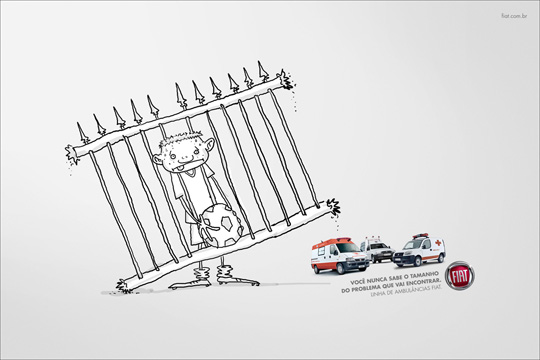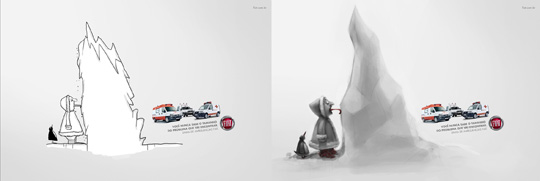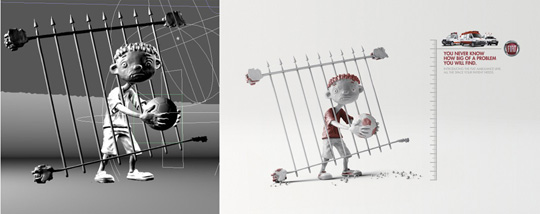Blog
Vetor Zero Teams Up With Leo Burnett for Award-Winning Fiat Ambulance Campaign
Written by: Scott Strohmaier
Advertising a car in these hard economic times can be very challenging, so creating a magazine ad that will effectively sell an ambulance might be deemed an impossible task. That is, unless you’re Vetor Zero — an award-winning commercial animation studio in São Paulo, Brazil.
When Vetor Zero got the job of helping Fiat sell their ambulances, they knew the ads had to be something special. The car company’s ambulance line was about to be announced in a Brazilian magazine and it was Vetor Zero’s job to help them do it in a way that grabbed people’s attention. Daniel Sian, a 3D generalist/illustrator with Vetor Zero brought the ads to life using a combination of software. Maxon’s Cinema 4D was used for modeling, lighting and rendering. Sculpting was done with Pixelogic’s ZBrush and Photoshop was a key post-production tool.

Layouts created by Leo Burnett’s Brazilian office made clear the benefit of Fiat’s ambulance line with the slogan: “You never know how big the problem will be.”
After receiving the original conceptual layouts from Chicago-based Leo Burnett’s Brazilian office, Marco Furtado, the illustrator working with Vetor Zero on the project, developed new concepts based on the original idea and proposed improvements. With both ambulances and hospitals not being particularly funny, the creative team opted to focus on ways to convey the benefits of ambulances, says Sian, who joined Vetor Zero in 2010 after being the lead Cinema 4D instructor at Brazil’s CAD Technology Sistemas, (a Maxon distributor) for several years. (See more of Sian’s work here)
Illustrator Marco Furtado expanded on the agency’s original ideas and enhanced the look with color and detail.
“The illustration and advertising market in Brazil is promising for good professionals and after some years of studying, I decided to venture into the market, combining 3D techniques with my previous experience as an artist focused on drawing and painting,” he says.
Base meshes for each concept were modeled in C4D and exported to ZBrush, where they were sculpted.
The making of an award-winning campaign
As the team mulled over the possibilities for the Fiat campaign, they started asking themselves what some of the funniest examples of mishaps and accidents that could possibly happen in real life might be. A guy gets his outstretched tongue stuck to a giant slab of ice. Another guy somehow jammed his head into a cannon, and a kid (going after a ball) gets his head stuck in the bars of a metal fence. Artfully drawn, modeled and executed, the project’s humorous outcome earned Vetor Zero one silver and two bronze awards and Cannes Lions, as well as one bronze Clio Award in 2011. (Check out Vetor Zero’s site)
Once the artwork was approved by the agency, Sian led the CG creation while Furtado handled art direction. (See more of Furtado’s work here). In order to match the modeling to the original concept art as closely as possible, a locked-off camera was used in conjunction with the concept images in the actual Cinema 4D viewport. “The modeling was all done by switching between the fixed camera and the editor view to assure a good match to the art,” Sian explains.
Vetor Zero CG artist Daniel Sian used Cinema 4D for modeling, lighting and rendering on the Fiat project. ZBrush was used for sculpting, and Photoshop for post-production.
Sian used ZBrush intensively for the first time while working on this project. “That was biggest challenge because I had to generate a texture for the models as if they were handmade of clay or something,” he says.
But before moving the mesh to ZBrush for refinement, Sian created the basic polygon models in C4D and prepared the quality UV maps that ZBrush requires. Sian had some experience with Headus’ UVLayout, since it is widely used by VetorZero. But for this project, BodyPaint’s UV tools proved to be the best choice.
ZBrush was used to create the soft clay-like surfaces Sian used to match the concept artwork.
Because the models were high resolution, each one was broken into sections to make working with them easier. Models were then exported to to ZBrush where the complex surfaces were refined and sculpted. Once back in Cinema 4D, Sian started experimenting with Displacement and Normal values so the models would be exactly the same in appearance as they were in ZBrush.
In the final image, ZBrush texturing and C4D’s global illumination work together to create the illusion of a real-life clay model.
Finally, the scene was rendered with Global Illumination at very high resolution, and C4D’s multi-pass render feature was used to get the various passes necessary to have broad latitude in the post work done in Photoshop.
Final compositing was done by Sian and Furtado with colorization by Andre? Souza and Claudio Di Bernardo.
Because there was literally no scenery, Sian’s only choice was to enhance the lone character in each ad. To make the absence of scenery irrelevant and heighten each character’s highlights, he enhanced the lighting that Furtado proposed in the rough. When talking about the attention the campaign has received, Sian is quick to emphasize that it was only possible through great teamwork. In particular, he credits Furtado with whom he worked closely for the duration of the two-month project. “I’m very happy we won the awards, which were the result of a lot of hard work and dedication,” Sian says.
Scott Strohmaier is a writer living in Los Angeles living with his wife and son.





